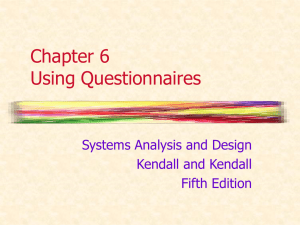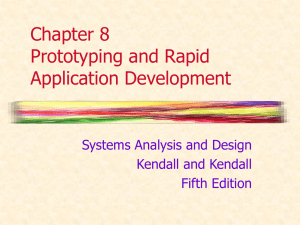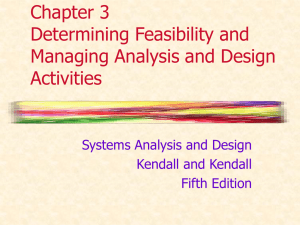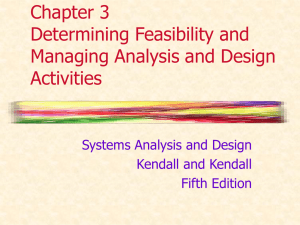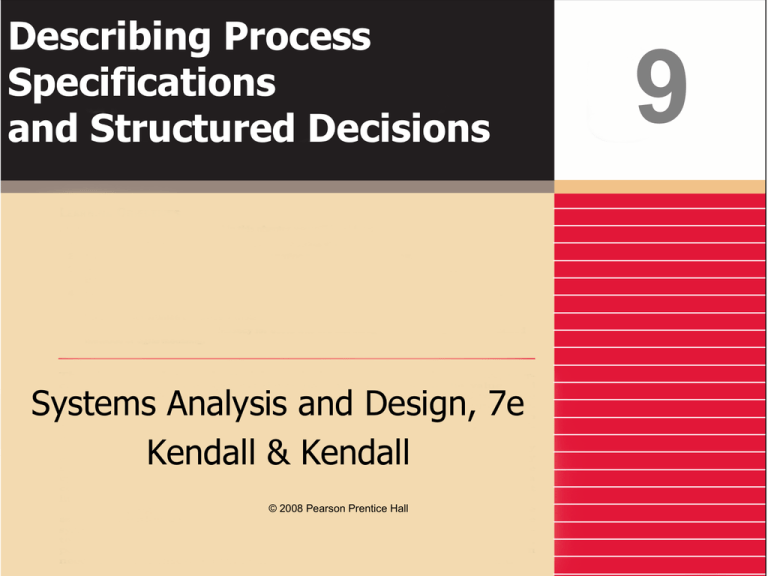
Describing Process
Specifications
and Structured Decisions
Systems Analysis and Design, 7e
Kendall & Kendall
© 2008 Pearson Prentice Hall
9
Logic of Decisions
• Documenting and analyzing logic:
• Structured English
• Decision tables
• Decision trees
• Logic and structured decisions are
distinguishable from semistructured decisions
• Structured decision analysis methods promote
completeness, accuracy, and communication
Kendall & Kendall
9-2
Major Topics
•
•
•
•
•
•
Process specifications
Business rules
Structured English
Decision tables
Decision trees
Horizontal balancing
Kendall & Kendall
9-3
Process Specifications
• Sometimes called minispecs
• Created for primitive processes as well
as for some higher level processes on a
data flow diagram
• Created for class methods in objectoriented design and for the steps in a
use case
Kendall & Kendall
9-4
Goals of Producing Process
Specifications
• Reduce process ambiguity
• Obtain a precise description of what is
accomplished
• Validate the system design
Kendall & Kendall
9-5
Process Specifications Are Not
Created
• Processes that represent physical input
and/or output
• Processes that represent simple data
validation
• Processes that use prewritten code
Kendall & Kendall
9-6
Figure 9.1 How process specifications
relate to the data flow diagram
Kendall & Kendall
9-7
Process Specification Format
Information
•
•
•
•
•
•
•
•
•
•
The process number
The process name
Description of what the process accomplishes
A list of input data flow
Output data flows
Type of process
Uses prewritten code
Process logic description
Logic method reference
List any unresolved issues
Kendall & Kendall
9-8
Figure 9.2 An example of a completed process
specification form for determining whether an item is
available
Kendall & Kendall
9-9
The Process Number
• Must match the process ID on the data
flow diagram
• Allows the analyst to work on or review
any process, and to locate the data flow
diagram containing the process easily
Kendall & Kendall
9-10
The Process Name
• The same as displays within the process
symbol on the DFD
Kendall & Kendall
9-11
Description of What the Process
Accomplishes
• Example:
Determine if an item is available for sale. If
it is not available, create a backordered
item record. Determine the quantity
available
Kendall & Kendall
9-12
List of Input Data Flow
• Uses the names found on the data flow
diagram
• Data names used in the formulae or
logic should match the data dictionary,
for consistency and good
communication
Kendall & Kendall
9-13
Output Data Flows
• Uses data flow diagram and data
dictionary names
Kendall & Kendall
9-14
Type of Process
• Batch
• Online
• Require screen designs
• Manual
• Should have well-defined procedures for
employees performing the process tasks
Kendall & Kendall
9-15
Uses Prewritten Code
• Include the name of the subprogram or
function containing the code
Kendall & Kendall
9-16
Process Logic Description
• This should state policy and business
rules, not computer language
pseudocode
• Business rules are the procedures that
allow a corporation to run its business
Kendall & Kendall
9-17
Figure 9.2 An example of a completed process
specification form for determining whether an item is
available
Kendall & Kendall
9-18
Common Business Rule Formats
•
•
•
•
•
•
•
Definitions of business terms
Business conditions and actions
Data integrity constraints
Mathematical and functional derivations
Logical inferences
Processing sequences
Relationships among facts about the business
Kendall & Kendall
9-19
Logic Method Reference
• If there is not enough room for a
complete structured English description
include a reference to the structured
English description, decision table, or
tree depicting the logic
Kendall & Kendall
9-20
List Any Unresolved Issues
• Incomplete portions of logic
• These issues form the basis of the
questions used for follow-up interviews
with users or business experts you have
added to your project team
Kendall & Kendall
9-21
Figure 9.2 An example of a completed process
specification form for determining whether an item is
available
Kendall & Kendall
9-22
Structured English
• Used when the process logic involves
formulas or iteration, or when
structured decisions are not complex
• Based on structured logic and Simple
English statements such as add,
multiply, and move
Kendall & Kendall
9-23
Writing Structured English
• Express all logic in terms of sequential
structures, decision structures, case
structures, or iterations
• Use and capitalize accepted keywords such as
IF, THEN, ELSE, DO, and PERFORM
• Indent blocks of statements to show their
hierarchy (nesting) clearly
• Underline words or phrases that have been
defined in a data dictionary
• Clarify the logical statements
Kendall & Kendall
9-24
Figure 9.4 Examples of logic expressed in a
sequential structure, a decision structure, a case
structure, and an iteration
Kendall & Kendall
9-25
Advantages of Structured
English
• Clarifying the logic and relationships
found in human languages
• An effective communication tool, it can
be taught to and understood by users in
the organization
Kendall & Kendall
9-26
Data Dictionary and Process
Specification
• The data dictionary is a starting point
for creating structured English:
• Sequence - a simple sequence of
statements MOVE, ADD, and SUBTRACT
• Selection - [] entries become
IF..THEN...ELSE statements
• Iteration { } entries become DO WHILE,
DO UNTIL, or PERFORM UNTIL
Kendall & Kendall
9-27
Decision Tables
• A table of rows and columns, separated
into four quadrants
•
•
•
•
Kendall & Kendall
Conditions
Condition alternatives
Actions to be taken
Rules for executing the actions
9-28
Figure 9.8 The standard format
used for presenting a decision table
Kendall & Kendall
9-29
Figure 9.10 Constructing a decision table for deciding
which catalog to send to customers who order only from
selected catalogs
Kendall & Kendall
9-30
Developing Decision Tables
•
•
•
•
•
•
•
•
•
Determine conditions that affect the decision
Determine possible actions that can be taken
Determine condition alternatives for each condition
Calculate the maximum number of columns in the
decision table
Fill in the condition alternatives
Complete table by inserting an X where rules suggest
actions
Combine rules where it is apparent
Check for impossible situations
Rearrange to make more understandable
Kendall & Kendall
9-31
Checking for Completeness and
Accuracy
• Four main problems
•
•
•
•
Kendall & Kendall
Incompleteness
Impossible situations
Contradictions
Redundancy
9-32
Figure 9.14 Checking the decision table for
inadvertent contradictions and redundancy is
important
Kendall & Kendall
9-33
More Advanced Decision Tables
• As the number of alternatives and conditions
grow the number of columns increases
• A table with seven conditions each having two
alternatives would need 128 columns
• To reduce the number of columns
• Use extended entries
• Use the ELSE rule
• Construct multiple tables
Kendall & Kendall
9-34
Decision Table Advantages
• Help the analysis ensure completeness
• Easy to check for possible errors
• Impossible situations
• Contradictions
• Redundancy
Kendall & Kendall
9-35
Decision Trees
• Decision trees are used when complex
branching occurs in a structured
decision process
• Trees are also useful when it is
essential to keep a string of decisions in
a particular sequence
Kendall & Kendall
9-36
Drawing Decision Trees
• Identify all conditions and actions and
their order and timing (if they are
critical)
• Begin building the tree from left to
right, making sure you list all possible
alternatives before moving to the right
Kendall & Kendall
9-37
Decision Table... Convert to
Decision Tree
Kendall & Kendall
9-38
Figure 9.15 Drawing a decision tree to show
the noncash purchase approval actions for a
department store
Kendall & Kendall
9-39
Example (pg 330 prob 6)
• A computer supplies firm called True Disk has set up accounts
for countless businesses in Dosville. True Disk sends out
invoices monthly and will give discounts if payments are made
within 10 days. The discounting policy is as follows: If the
amount of the order for computer supplies is greater than
$1,000, subtract 4 percent for the order; if the amount is
between $500 and $1,000, subtract a 2-percent discount; if the
amount is less than $500, do not apply any discount.
Kendall & Kendall
9-40
Example (pg 330 prob 6)
• A computer supplies firm called True Disk has set up accounts
for countless businesses in Dosville. True Disk sends out
invoices monthly and will give discounts if payments are made
within 10 days. The discounting policy is as follows: If the
amount of the order for computer supplies is greater than
$1,000, subtract 4 percent for the order; if the amount is
between $500 and $1,000, subtract a 2-percent discount; if the
amount is less than $500, do not apply any discount.
Kendall & Kendall
9-41
Example (pg 330 prob 6)
No Discount
Payment
Made In
< Or =
18 Days?
No
4 % Discount
Yes
Yes
Order Total
> $1000?
2 % Discount
Yes
No
Order Total
> Or = $500?
No
Kendall & Kendall
No Discount
9-42
Example (pg 330 prob 6)
• A computer supplies firm called True Disk has set up accounts
for countless businesses in Dosville. True Disk sends out
invoices monthly and will give discounts if payments are made
within 10 days. The discounting policy is as follows: If the
amount of the order for computer supplies is greater than
$1,000, subtract 4 percent for the order; if the amount is
between $500 and $1,000, subtract a 2-percent discount; if the
amount is less than $500, do not apply any discount.
Kendall & Kendall
9-43
Example (pg 330 prob 6)
No Discount
Payment
Made In
< Or =
18 Days?
No
4 % Discount
Yes
Yes
Order Total
> $1000?
2 % Discount
Yes
No
Order Total
> Or = $500?
No
Kendall & Kendall
No Discount
9-44
Example (pg 330 prob 6)
• A computer supplies firm called True Disk has set up accounts
for countless businesses in Dosville. True Disk sends out
invoices monthly and will give discounts if payments are made
within 10 days. The discounting policy is as follows: If the
amount of the order for computer supplies is greater than
$1,000, subtract 4 percent for the order; if the amount is
between $500 and $1,000, subtract a 2-percent discount; if the
amount is less than $500, do not apply any discount.
Kendall & Kendall
9-45
Example (pg 330 prob 6)
No Discount
Payment
Made In
< Or =
18 Days?
No
4 % Discount
Yes
Yes
Order Total
> $1000?
2 % Discount
Yes
No
Order Total
> Or = $500?
No
Kendall & Kendall
No Discount
9-46
Decision Tree Advantages
• The order of checking conditions and
executing actions is immediately noticeable
• Conditions and actions of decision trees are
found on some branches but not on others
• Compared to decision tables, decision trees
are more readily understood by others in the
organization
Kendall & Kendall
9-47
Selecting a Structured Decision
Analysis Technique
• Use structured English when there are many
repetitious actions or when communication to end
users is important
• Use decision tables when complex combination of
conditions, actions, and rules are found or you
require a method that effectively avoids impossible
situations, redundancies, and contradictions
• Use decision trees when the sequence of conditions
and actions is critical or when not every condition is
relevant to every action (the branches are different)
Kendall & Kendall
9-48




